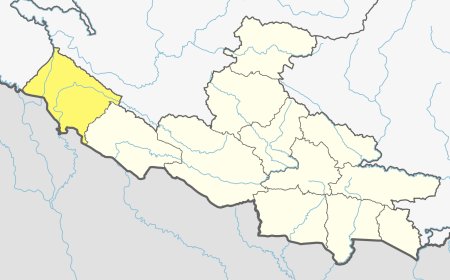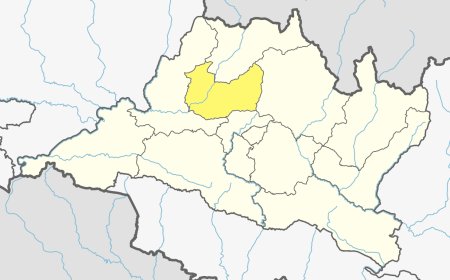Nepal-United States Relationship: A Comprehensive Overview
Explore the dynamic relationship between Nepal and the United States, from historical ties to shared objectives in development, politics, geopolitics, and economics. Learn about their collaborative efforts and evolving partnership.

Introduction
The diplomatic relationship between Nepal and the United States has evolved significantly since its establishment in 1947. Over the years, the two nations have collaborated on various fronts, ranging from development initiatives to geopolitical strategies in the Indo-Pacific region. This article provides a comprehensive overview of Nepal-U.S. relations, exploring historical developments, shared objectives, challenges, and the role of the U.S. Embassy in Kathmandu.
Historical Background
The diplomatic relationship between Nepal and the United States was established in 1947 when the United States became one of the first countries to recognize Nepal's independence. At that time, Nepal was an isolated and impoverished monarchy with limited international engagement. The historical background of Nepal-U.S. relations can be summarized in three key phases.
-
Early Engagement (1947-1980s)
- The United States played a pivotal role in recognizing Nepal's independence, making it one of the early nations to establish diplomatic relations with the Himalayan kingdom.
- Due to Nepal's self-imposed isolationist policies during this period, direct bilateral engagement was limited. Nepal's strategic position in the region was not fully realized.
-
Post-Cold War Era (1990s-2000s)
- The end of the Cold War marked a significant shift in Nepal-U.S. relations, opening up new avenues for cooperation.
- During this phase, the United States increased its engagement in Nepal's development, focusing on reducing child mortality, alleviating poverty, and improving healthcare.
-
Contemporary Relations (2010s-Present)
- Nepal underwent a significant political transformation, transitioning into a federal democratic republic.
- This period also witnessed evolving U.S. priorities in the Indo-Pacific region, with a growing emphasis on countering China's influence, making Nepal's geopolitical significance more pronounced.
Nepal-U.S. relations have evolved significantly over the decades, reflecting changes in global and regional dynamics, as well as the shifting priorities of both nations. The historical background lays the foundation for understanding the current state of this diplomatic relationship.
Shared Objectives
Nepal and the United States have worked together on several shared objectives, with a focus on socio-economic development, political stability, geopolitical significance, and economic partnerships. These objectives have transformed and expanded over time, reflecting the evolving dynamics of the bilateral relationship.
-
Development Cooperation:
- The United States has provided substantial support to Nepal's development endeavors, addressing challenges such as reducing child mortality, alleviating poverty, and enhancing healthcare access.
- Collaborative efforts have contributed to the considerable progress Nepal has made in improving healthcare and living conditions for its citizens.
-
Political Stability:
- The United States played a role in encouraging Nepal's transition from a monarchy to a federal democratic republic.
- Their engagement aimed to foster political stability in Nepal by supporting democratic processes and governance structures.
-
Geopolitical Significance:
- Nepal occupies a strategic position in the U.S. Indo-Pacific strategy, serving as a potential counterbalance to China's influence in the region.
- The evolving geopolitics of the Indo-Pacific have led to greater U.S. interest in strengthening Nepal as a diplomatic partner.
-
Economic Partnerships:
- The United States has invested in Nepal through infrastructure grants and financial assistance.
- Initiatives focused on promoting entrepreneurship, clean energy projects, and sustainable economic growth, demonstrating a commitment to Nepal's long-term prosperity.
These shared objectives underscore the multifaceted nature of Nepal-U.S. relations, reflecting the commitment of both nations to achieving common goals in various domains. Their collaboration extends beyond diplomatic interactions, encompassing socio-economic development and regional geopolitics.
Challenges
Nepal-U.S. relations face several challenges that influence the trajectory of this diplomatic partnership. These challenges encompass political instability, the influence of China, economic struggles, and Nepal's foreign policy balancing act.
-
Political Instability:
Nepal's frequent changes in leadership contribute to political instability. This instability can disrupt long-term development plans and cooperation with the United States. -
China's Influence:
China's increasing investment and political influence in Nepal pose significant challenges. Nepal has become a focal point in the competition between the U.S. and China in the Indo-Pacific region. -
Economic Struggles:
Nepal faces economic challenges, including high inflation. These economic constraints can impede Nepal's ability to pursue long-term strategic objectives and development. -
Foreign Policy Balancing:
Nepal's foreign policy emphasizes maintaining a delicate balance in relations with China, India, and the United States. Managing these intricate geopolitical dynamics and keeping positive engagement with major powers is an ongoing challenge. -
Geopolitical Competition:
Increased U.S. engagement to counterbalance China in Nepal creates challenges. Managing U.S.-China competition while protecting Nepal's sovereignty and interests is complex. -
Energy Infrastructure:
Meeting Nepal's energy infrastructure needs requires substantial investment. Balancing between U.S. and Chinese involvement in energy projects is a challenge. -
Corruption:
Corruption remains a persistent issue in Nepal, affecting governance, development, and foreign investment. -
Historical Grievances:
Nepal grapples with historical grievances related to the Maoist insurgency, discrimination, and governance issues, which can impact stability. -
Geopolitical Position:
Nepal's geopolitical position between China and India adds complexity. Balancing relations with both neighbors and the United States is challenging. -
Sustainability and Environmental Concerns:
Nepal faces environmental challenges such as deforestation, water pollution, and climate change impacts. Balancing economic development with environmental sustainability is a growing concern and requires cooperation with the United States on environmental initiatives.
Addressing these challenges is essential to building a stable, prosperous Nepal and advancing U.S. interests in the Indo-Pacific region.
The Role of the U.S. Embassy in Kathmandu
The U.S. Embassy in Kathmandu is a pivotal actor in shaping and advancing Nepal-U.S. relations. It serves as a hub for diplomatic engagement and strategic initiatives, playing a multifaceted role to promote shared objectives, navigate challenges, and drive efficient diplomacy.
-
Results-Oriented Engagement:
- The U.S. Embassy employs strategic campaigns to promote U.S. objectives in Nepal. These campaigns blend diplomatic efforts with targeted public outreach to generate demand for reforms and catalyze action.
- Public lectures by U.S. exchange alumni, op-eds authored by the U.S. Ambassador, public events, and social media campaigns are coordinated to address key issues each month. For instance, campaigns have focused on disaster risk reduction, entrepreneurship, and transparent governance.
- Notably, these campaigns have yielded tangible results, including pushing for the ratification of the Palermo Trafficking in Persons (TIP) Protocol, influencing Nepal's adoption of USAID's farm productivity and market linkage model, and driving the passage of a long-stalled Disaster Management Authority bill.
-
Restructuring and Efficiency:
- To enhance its effectiveness and adapt to evolving dynamics, the U.S. Embassy in Kathmandu has restructured its operations. This transformation seeks to focus on shared objectives and streamline operations for maximum impact.
- Instead of organizing itself based on the agencies that employ its staff, the embassy has restructured its team into interagency Integrated Country Strategy (ICS) Teams. Each ICS Team is co-chaired by section chiefs from different agencies, who work collaboratively to develop common strategies and set annual objectives.
- These action plans identify the most meaningful and achievable targets for the embassy to pursue, incorporating ongoing and special efforts that various component offices will lead.
-
Coordination and Collaboration:
- Collaboration is at the core of the embassy's approach to diplomacy. The creation of ICS Teams facilitates a shared understanding of key objectives and strategies.
- The interagency ICS Teams are physically co-located within the embassy, allowing for real-time collaboration, efficient sharing of information, and the opportunity for teams to complement each other's efforts.
- This streamlined approach ensures that all teams are aligned with the embassy's overarching goals and allows for better resource allocation and strategy implementation.
-
Innovation and Technology:
- Leveraging technology is another cornerstone of the embassy's efficient operations. By adopting modern technological tools, the embassy aims to optimize its working methods.
- Embassy staff have been granted accounts on the Foreign Affairs Network, which allows for faster and more efficient document clearance. Multiple authors can work on documents simultaneously, reducing clearance times.
- Additionally, collaboration spaces with laptops, whiteboards, and brainstorming-conducive layouts are being established to facilitate productive group work and discussions. These spaces encourage more efficient teamwork and idea generation, as well as more agile document creation.
In summary, the U.S. Embassy in Kathmandu has adopted a forward-thinking approach to diplomacy. Its innovative strategies, focusing on result-oriented engagement, restructuring for efficiency, collaboration, and technology utilization, have proven successful in advancing shared objectives and addressing the challenges of Nepal-U.S. relations. This approach sets a precedent for modern diplomacy and demonstrates how diplomatic missions can adapt to the demands of the 21st century to achieve greater results. The embassy's role in fostering development, security, and stability in Nepal exemplifies the evolving nature of international partnerships.
Conclusion
Nepal–United States relations have come a long way since the initial recognition of Nepal's independence. The diplomatic ties have been influenced by regional geopolitics, shared development objectives, and the challenges that both nations face. The U.S. Embassy in Kathmandu's innovative approach to promoting shared objectives sets a precedent for modern diplomacy. The collaboration between the two nations continues to evolve, presenting opportunities and challenges in an ever-changing global landscape.
In this complex and dynamic environment, Nepal and the United States share a mutual interest in ensuring the stability and prosperity of Nepal, which contributes to regional peace and security. The ongoing collaboration between these nations offers a unique case study of how diplomacy can adapt to the demands of the 21st century, and how innovative strategies can help overcome challenges and advance shared objectives. The Nepal-U.S. relationship remains a compelling example of international partnerships aimed at fostering development, security, and stability in a complex world.
What's Your Reaction?








































































































